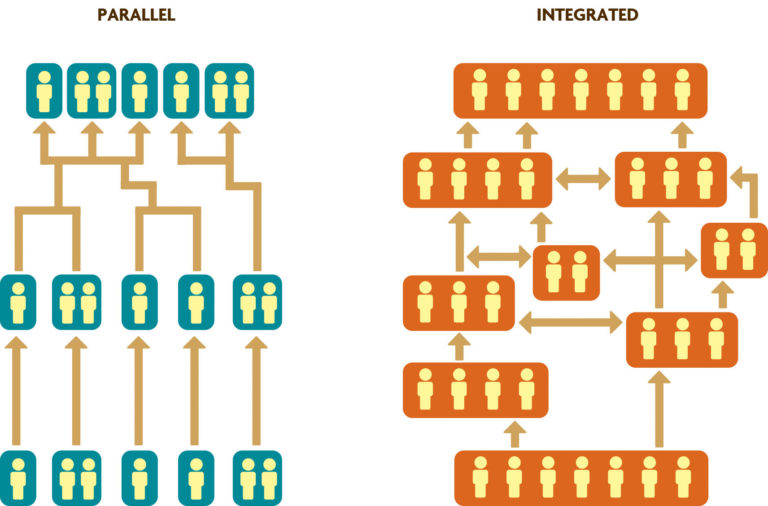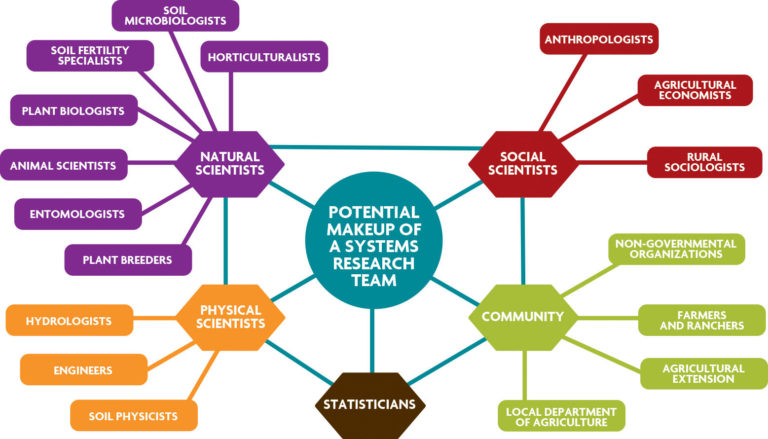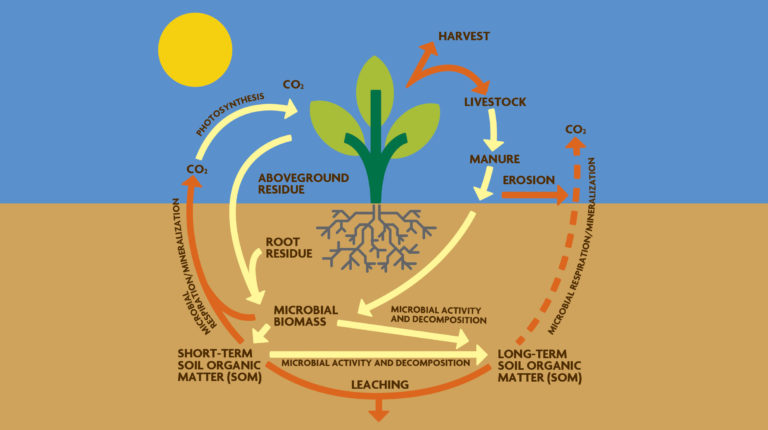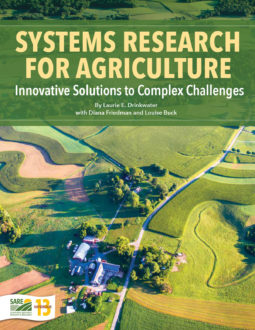Commonly, collaborative research groups in universities organize as loosely affiliated individuals with a project leader who coordinates the various research components. This “multidisciplinary” mode of working together is the most common approach to collaboration, in part because it requires less time in meetings and allows individuals to work in a business-as-usual way within a larger coordinated project. Using this approach, team members work in parallel and come together periodically to integrate their work. While well suited for some projects, multidisciplinary groups often do not progress beyond a compartmentalized model and typically miss important, complex interactions occurring within the system under study.
In contrast, interdisciplinary research requires the core research group to function as an integrated team. The team members work together at all stages—information gathering, design, implementation and analysis—to obtain a holistic understanding of the system under study.
Effective collaborative teams also use shared and democratically styled leadership, create and foster a group culture conducive to free discourse and participatory decision making, and highlight a group planning process that emphasizes a high degree of interdependence to achieve a common goal.
Role of the Project Leader
Effective collaborative teams also use shared and democratically styled leadership, create and foster a group culture conducive to free discourse and participatory decision making, and highlight a group planning process that emphasizes a high degree of interdependence to achieve a common goal.
Project leaders must be aware of their own biases and must genuinely value the diversity of the team they are assembling. They must be open to understanding how scientists from other fields approach their own research and questions and how scientists and nonscientists communicate. They should also be aware of how their own beliefs, values and assumptions influence their leadership style.
Project leaders must also be flexible; agricultural systems research requires the leader’s role to continually evolve as the group coalesces into a working team. As the project progresses from planning to implementation, the project leader must guide the team in developing a decision-making framework that encourages innovative problem solving. When the team hits hurdles and bumps, the project leader will need to inspire team members to maintain the shared vision of the project by keeping the focus on the system-level questions and on relating each member’s work to these questions.
Skills Required for Effective Leadership of Collaborative Research Projects (modified from Clark, 1977)
Communication
- Use clear communication in both individual and group settings
- Listen actively
- Use appropriate interpersonal style(s) to steer team members toward goals
- Delegate decision-making and other responsibilities to appropriate individuals
Interpersonal skills
- Build appropriate relationships and help the team network with peers and associates
- Create a culture of cooperation by facilitating interaction, open communication and participatory decision-making
Professionalism
- Maintain technical competence by staying current on literature and systems and collaborative research methodologies, and by acquiring general knowledge of the other disciplines involved in the project
- Set a good example by modeling consideration of others and by flexibility and adherence to high standards of performance
Recognition
- Praise contributions from participants
- Establish fair and inclusive norms for authorship in scientific publications
Project management
- Set a course, monitor and adapt it (using team decisions), and deal effectively with external forces that influence the team’s goals
- Establish norms to foster effective meetings and record keeping, e.g., meeting goals, agendas and documenting meetings through notes and action steps
- Be financially responsible and resourceful, and ensure that funds are distributed fairly
An effective project leader will also have strong management skills. After initiating the formation of a group with common goals, the project leader must be able to organize the group effectively, set decision-making protocols and guide the team to accomplish those goals. In general, team leaders should strive for a democratic leadership style that allows major decisions to be made through consultation and participation, while maintaining a level of control that corresponds to the leader’s accountability for the project. The project leader’s ability to gauge the level of participation appropriate for a given decision is key to satisfactory group processes. A strong leader will follow through on commitments to the group and will protect the team within the institutional framework by justifying their work to others as an integral part of a larger project.
Effective leaders are trustworthy and provide clear communication of vision (Clark, 1997). These traits establish credibility with prospective team members and increase the likelihood that they will want to participate in a collaborative venture. Being a good listener and staying open-minded, inclusive and adaptive are key.
Project leaders need to keep members engaged and focused and find a balance between providing and sharing leadership. During the initial planning stages, the project leader plays a central role by bridging gaps between disciplines and stakeholders, integrating ideas and helping the group to develop a coherent framework. As team members become familiar with one another’s perspectives and working styles, responsibilities can be shared, with different members assuming leadership roles. The leader must consider that agricultural systems research teams require a variety of leadership roles and that careful sharing of leadership can contribute to the project’s overall strength. For example, some team members may resist full participation in the project because they did not initiate it and cannot be in complete control of their work. Such members will likely need to assume a leadership role to feel fully invested.
Assembling the Core Team
The composition of the project team is very important to the success of a collaborative project. Usually, the project leader invites participants to join the project. In some cases, an established group may want to use a group process to add new team members.
For successful team selection, begin by choosing colleagues and stakeholders who bring expertise from key disciplines, have compatible personalities and are willing to work in groups. Ideally, people involved in interdisciplinary research should be interested in learning about the theories and methods of other disciplines.
Be cautious about colleagues who lack good interpersonal communication skills or who complain about collaborative work. While collaborative behavior can be learned, avoid working with people who are clearly disinclined to such work. Identify the expectations prospective collaborators have for the project to get a good sense of whether they will be a good fit and to ensure they are engaged in way that meets their own needs as well as that of the team. Pay attention to the personalities of potential members. For example, does the individual need to be in control of his or her research or is he/she flexible regarding collaborators’ expectations for the project? Is he or she willing to let others influence project outcomes and open to using participatory decision-making?
While teams should include a mix of junior and senior faculty, give special consideration when asking untenured faculty to join the project. Be prepared to provide them with adequate support and recognition if they must meet tenure requirements while participating in a collaborative project.
Become familiar with the work of prospective team members by visiting their websites or farms and reading their recent research articles and extension publications—especially when looking for participants outside the leader’s discipline and academic circles. Solicit suggestions from colleagues who know researchers in other fields or who have worked with farmers who could be well suited to the project, especially those who have experience with collaboration, are known to work well with others and are willing to assume and share leadership responsibility.
In addition to scientists and farmers, seek out farm advisers, extension educators and leaders from other relevant groups, such as farming and environmental organizations. These professionals make good all-around team members; they are intimately familiar with farm operations, bring a different perspective than researchers and farmers, and can be very helpful with data collection and evaluation.
Finally, try to select farmers who are willing to be involved from the project’s inception and who can engage with the core team as equals in the decision-making process. Selected farmers should have experience collaborating with researchers. Ideally, they should understand and appreciate the research process, and they should have a systems-level understanding of agriculture and the ability to frame day-today farm problems in that context. Farmers on the core team (as well as others who play specific roles in the project) should be compensated financially whenever possible.
Engaging Farmers and Other Nonacademic Stakeholders in Systems Projects
Farmers are key partners in agricultural systems research. Depending on how broadly a team has defined the system boundaries and the project goals, other stakeholders such as extension educators, food distributors, consumer groups, certification specialists, community development planners, natural resource conservationists and policymakers may also be valuable contributors.
Given the wide range of professionals that a systems project may involve, careful thought must be given as to how the team will be managed. There are three basic models for project decision-making and leading: science-led, farmer- led, and interactive (also known as participatory) (Lilja and Ashby, 1999).
The science-led model is widely used in conventional research, where the interests and demands of scientific research determine the project plan. Researchers invite farmers to provide information and expertise, but their input is often sought only in the late or final stages of project development.
In the farmer-led model, farmers determine the project goals and priorities, and researchers mainly assist with the research aspects (e.g., suggesting the statistical design and data-collection methods). This uncommon approach is gaining influence in regional programs and is a cornerstone of SARE’s farmer/rancher grants. SARE producer grants encourage farmers and ranchers to partner with scientists to design and implement research addressing innovations they wish to test on their farms. The Practical Farmers of Iowa have also implemented a successful farmer-led research process (Box 2.1).
Box 2.1: Farmer-Led Model of Agricultural Research
In 1985, the Practical Farmers of Iowa (PFI), led by a small group of progressive farmers with support from scientists at Iowa State University (ISU), began a farming systems research project. The goal of the project was to develop knowledge and information that would support PFI’s vision of sustainable agriculture for their membership and region. Today, the initiative has evolved into a long-term program through which PFI invites ISU scientists to collaborate in setting the research agenda and in obtaining funding. PFI also encourages farmers to conduct research independently of ISU and to make their findings available through farmer-to-farmer training workshops, publications, and PFI’s website. The organization has produced detailed guidelines for designing, managing and analyzing research; this research often compares normal farmer practices with experimental management regimes. Information about the research process and outcomes of PFI-led research are available at www.practicalfarmers.org.
The interactive model of leadership links farmer researchers with scientists and requires them to work closely together throughout the lifespan of the research. Researchers and farmers are equal participants in developing goals and priorities for the group, and joint decision-making occurs at the earliest stages. Known in some circles as participatory research, this type of decision-making is becoming more common and is the most effective method for researcher-led projects because close involvement from experienced, knowledgeable farmers helps ensure that the project will reflect true agricultural systems.
Practical distinctions among the three models are a matter of degree. Sometimes, funders specify the roles of various stakeholders. Ideally, agricultural systems research includes participation by stakeholders outside the university. To facilitate effective interactions between scientists and farmers, prospective leaders need to be prepared for a range of challenges and able to identify viable solutions (see SAFS case study, p. 35).
Farmers and others outside academia face unique barriers when participating in agricultural systems research, and project leaders should be prepared to address these challenges. While participation in formal research is required of professional scientists, it is not usually necessary in other stakeholders’ professions. The challenge is to tie the research to outcomes that nonacademic stakeholders will find interesting and useful and that will encourage their participation. Compensating stakeholders for the time they commit to project meetings and for travel can also encourage participation.
Challenges to and Strategies for Keeping Farmers Engaged
Forming sustainable partnerships between the research community and farmers is an ongoing process that requires negotiation, patience and persistence. Begin with gradual establishment of trust, communication and shared philosophy during proposal development to allow relationships to develop with friendship, openness and continuity. This approach will also support farmers’ engagement with the project and can help extend mutually beneficial farmer–researcher relationships beyond the final publications and grants.
Research priorities will often differ between the two groups; be sure to discuss how those different goals and constraints affect the collaboration. Scientists are generally most interested in generating a new understanding of how systems work, while farmers want to solve current problems and improve their farming systems. These differences will determine how research goals are prioritized. Make sure to communicate how the research is relevant to farming and make a real effort to include farmers’ priorities in the research plan. Farmers and academic collaborators should be treated equally.
Both farmers and scientists lead busy lives and may be reluctant to attend meetings, especially if they do not see clear outcomes. Therefore, be conscientious about making efficient use of meeting time. Farmers should know why the researchers seek their participation in a meeting and what is expected of them. When time is short, representative scientists and farmers can be designated to meet on behalf of the research team. This works well for fine-tuning group decisions or for day-to-day management decisions, but it is not a substitute for group process. Conference calls or webinars can also be used.
Sometimes, projects can stall over mechanics. For example, considerations and constraints on plot design differ between on-farm trials and research stations because of equipment and resources such as labor. These differences need to be addressed when planning experiments in which farmers contribute to the design or provide research sites on their farms.
Keep in mind that unlike researchers, farmers do not earn their living from research and meetings. Thus, farmers should be compensated for their time and expertise, just as other professionals would expect to receive compensation. There are a number of strategies for compensating growers, including:
- Pay as you go: Farmers can be treated as consultants and paid on an hourly basis for well-defined activities. For example, they could be paid $25 to $35 per hour for participation in meetings.
- Annual stipend: Farmers can be offered a fixed annual stipend that reflects their level of involvement. Creating a detailed plan of the farmer’s participation helps determine that level; in general, annual stipends range from $200 to $2,500.
- Outcome-based compensation: Rather than being compensated for time, farmers can be paid for specific contributions. For example, a project that aimed to educate farmers through farmer-to-farmer transfers paid expert farmers for maintaining a farm website with specific attributes.
There are also multiple strategies to engage farmers, such as creating opportunities for farmers and researchers to meet regularly at coordinated site visits and annual winter workshops. Increasingly, networks of farmers are sponsoring on-farm research and public field days, workshops and demonstrations. Tapping into these events and into farmer- to-farmer networks that are familiar with or interested in research will go a long way in relationship building and can provide an entry point to engage farmers in diagnosing problems that lead to good research questions. Developing a process to bring new farmers into the program, e.g., by inviting them to annual spring forums to meet researchers and other farmers, will help facilitate interactions between newcomers and veterans that will help generate credibility with the farming community.
Instilling a Culture of Collaboration

Social scientists have long recognized that groups go through distinct stages in the process of becoming a team (Figure 2.1). Tuckman (1965) developed a widely used model of team evolution, proposing that as individuals form a team with a common purpose, the group tends to follow a pattern consisting of four stages:
- Forming: the group comes together for a purpose.
- Storming: the group struggles to establish a productive working relationship and to agree on priorities.
- Norming: the group establishes standards for accomplishing its goals.
- Performing: the group begins to function well as a whole.
Recognize that it is normal to face challenges during the development of a collaborative team; this will help the group have realistic expectations. The storming phase can be stressful if the group does not realize that conflict and discomfort are common during collaboration. Frequently, this stressful period occurs as team members struggle to make the paradigm shift from a reductive, component-oriented approach to an interdisciplinary, systems-level approach. The group should try to view the growing pains associated with storming as a normal part of developing relationships that provide the foundation for teamwork.

The transition from storming to norming is often initiated by successful adoption of common goals and objectives, which form cooperative strategies that become part of the team culture. The following list provides guidelines on how to develop a collaborative culture for agricultural system research:
- Establish a project timeframe that is long enough for iterative decision-making and regular patterns of interaction.
- Initiate frank discussions among members of the research group about collaborative work and decision-making. The group should discuss the differences between centralized and participatory decision-making, parallel and integrated organizational structures, and the various types of interdisciplinary approaches. A democratic form of decision-making is recommended, but regardless of what form is chosen, leaders should ensure that everyone understands it.
- Embrace a facilitative leadership style; encourage team members to participate in guiding meetings and to take responsibility for achieving the project goals.
- Start the process of team integration at the beginning of the project, and plan a combination of regular meetings and informal discussions.
- Develop a common language, limiting jargon and specialized terms that may not be understood or defined similarly across all fields. Acknowledge that this will take time, and allocate extra time for cross-disciplinary exchanges.
- Develop an open, honest culture of communication. Each person should be free to express how they see their role in the larger project as it unfolds. Check in with each individual to see how they feel about the group dynamics, and be prepared to address feedback in a respectful and constructive way.
- When possible, combine the process of project planning, goal development and proposal writing with socializing (e.g., a group meal) to support the evolution from a group with common interests to a working team.
- Decide what information will be exchanged among disciplines to promote communication and understanding of other disciplinary perspectives; set a timeline for disseminating this information.
- Educate new members about the team’s integrative approach to research and its collaborative work style. Leaders should not assume that new members will independently catch on to the complex project environment.
- Discuss how to deal with the loss of team members who depart before the project’s end, and share responsibility for filling the vacancy and integrating new members into the team.
Using Concept Mapping to Build Collaborative Teams

Concept mapping is a useful tool for building shared cognition, an essential building block of interdisciplinary research that can help team members understand one another’s disciplinary perspectives on a problem. Concept maps visually represent ideas around which common goals can be articulated; they convey meaning efficiently and aid in understanding complex information at a glance.
Participatory concept mapping begins with identifying a key problem or question that is fundamental to the research. A facilitated discussion helps ensure a common understanding of the words used to depict the problem. From there, the team can work in a parallel or integrated fashion to elaborate the causes and consequences of the problem and the relationships among these causes and consequences.
Using the parallel model, the facilitator asks each participant to create a concept map and then share it with the group. By helping the group compare and contrast the images, the facilitator helps the team to arrive at one common map.
In the integrated method, the facilitator has the group brainstorm plausible causes and effects and uses these inputs to help the group construct one common concept map that depicts relationships among the factors. This product is then used to develop the systems project concept map, which defines the system or problem to be studied.
Concept maps can be represented in various formats, including hierarchies, landscapes, systems or spider webs. Figures 2.3A and 2.3B depict systems and spider-web concept maps. For further discussion of how to use concept mapping to plan experiments, see Chapter 3.

